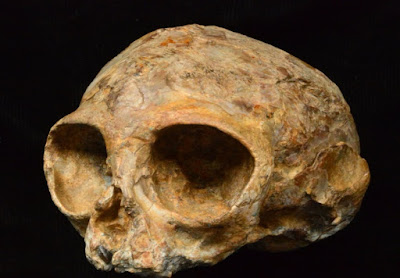 |
| Alesi the 13-million-year-old baby ape |
African fossil is considered as one of the crucial period because living things lived on that era were in Miocene epoch. This period is presented as era where the hominoids comprises isolated jaws and teeth while the knowledge of cranial evolution is little to be understood. However, the new species which the fossil was found by John Ekussi suggested new physiology of human. The nyanzapithecus has unerupted permanent teeth, ear which has canal with fully ossified tubular ectotympanic. These two developments in auditory sense and dental suggested they are in the middle of evolution.
Therefore, how could the scientists state that the new species in the genus Nyanzapithecus as our earliest ancestor? The answer is located on the skull characteristics. The team of scientists performed four examinations to its skull. They are systematic palaentology, cranial morphology, dental morphology and development, and endocranial volume, olfactory fossa, and inner ear [2]. The scientists also used the synchrotron radiation to determine where the species should be located in the history of evolution [3].
 |
| Alesi was found in Kenya near Lake Turkana |
The interesting thing about this skull is the nassals are tall and rectangular showing the differences to chimpanzees in all ages. On the other hand, the cranial breadth is the greatest as it is well-developed supramastoid crests. However, the overall dimension are similar to Symphalangus crania [2]. According to the paper which is published in Nature, Alesi had unusual advanced of teeth, more developing and this similarity of pattern is found in several primates only in Hylobates, Hoolock but not in Symphalangus (siamang) or Nomascus.
Hence, the Alesi’s characteristics can be found in certain primates and at the same time they cannot be found in certain primates too. Technically speaking, they are in the middle of two things either ape or huminoids. Interestingly, the endocranial volume which had been reconstructed implying the volume of 101 ml. With the development of dental (the thickness of enamel relative high around 12.2), the cranium of Nyanzapithecus alesi is more stable morphology ontogenetically even though the canal is relatively small.
To conclude, this skull ape showed several characteristics that can and cannot be found in several primates. However, the dental, cranium and auditory characteristics suggested that this 13 million-year-old-baby monkey has the most complete cranium as it described previously. Indicating the most development hominoid in the late Miocene epoch.
References
[1] S. Knapton, "Meet 'Alesi', the 13-million-year-old baby monkey which scientists say is mankind's earliest ancestor," The Telegraph, 09 August 2017. [Online]. Available: http://www.telegraph.co.uk/science/2017/08/09/meet-alesi-13-million-year-old-baby-ape-putting-face-earliest/. [Accessed 10 August 2017].
[2] I. Nengo, P. Taffoereau, C. C. Gilbert, J. G. Fleagle, E. R. Miller, C. Feibel, D. L. Fox, J. Feinberg, K. D. Pugh, C. Berruyer, S. Mana, Z. Engle and F. Spoor, "New infant cranium from the African Miocene sheds light on ape evolution," Nature, vol. 548, pp. 169-174, 2017.
[3] C. Gaffey, "Kenya: 13 Million year-old baby ape skull reveals what human ancestor may have looked like," Newsweek, 08 August 2017. [Online]. Available: http://www.newsweek.com/human-evolution-lake-turkana-human-ape-ancestor-649076. [Accessed 10 August 2017].
[4] Images are downloaded from www.telegraph.co.uk and www.newsweek.com
Tags
The Sciences